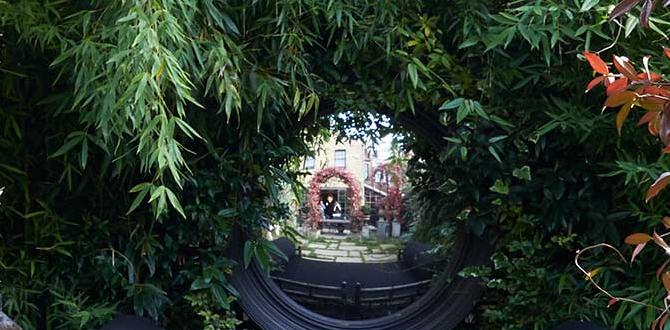Bolded Quick Summary: Mastering garden bed preparation is key to a flourishing garden. This guide provides essential, step-by-step tips to create the perfect foundation for healthy soil, robust plants, and abundant blooms, ensuring your gardening success from the very start.
Getting a garden started can feel a little overwhelming, right? You’ve got big dreams of vibrant flowers and tasty veggies, but the thought of preparing the actual garden bed might have you scratching your head. Where do you even begin? It’s a common hurdle, but don’t worry, it’s simpler than it sounds! With a few easy steps, you can transform any patch of ground into a welcoming haven for your plants. Let’s break down how to prepare your garden bed the right way, setting you up for a season of blooming success. Before you know it, you’ll be a garden prep pro!
Garden Bed Preparation: Essential Tips for Blooming Success
Welcome to the wonderful world of gardening! As Pearl Roach from EcoPatchy, I’m so excited to guide you on your green journey. Today, we’re digging into one of the most crucial steps for any gardener, whether you’re starting a flower bed, a veggie patch, or even just a few pots on your balcony: garden bed preparation. Think of it as building a cozy, nutrient-rich home for your plants. A well-prepared bed means healthier roots, stronger growth, and more beautiful blooms or delicious harvests. It might sound like a lot of work, but I promise to make it easy and even fun!
Whether you dream of a colorful flower garden, a bountiful vegetable patch, or fragrant herb containers, the foundation is everything. A prepared garden bed is literally the ground floor for your plant’s success. It’s where they’ll anchor their roots, find nourishment, and soak up water. Skipping this step is like trying to build a house without a solid foundation – it’s just not going to stand up well! But don’t worry, we’re here to walk through it together, ensuring your plants thrive from day one.
Why Great Garden Bed Preparation Matters
A happy plant starts with happy soil. When you prepare your garden bed properly, you’re doing so much more than just turning over dirt. You’re creating an environment that:
- Allows roots to grow deep and strong.
- Helps soil drain well, preventing root rot.
- Retains enough moisture for hydration.
- Provides essential nutrients for healthy growth.
- Improves soil structure, making it easier for air and water to penetrate.
Investing a little time in preparation now will save you a lot of headaches and boost your gardening success throughout the season. It’s truly the secret ingredient to those lush, vibrant gardens you admire!
Choosing Your Garden Bed Location
Before you even think about digging, let’s talk about where your garden will live. Most plants, especially vegetables and many flowering plants, need at least 6-8 hours of direct sunlight each day. Observe your yard or balcony throughout the day to see which spots get the most sun. Also, consider:
- Proximity to Water: You’ll be watering regularly, so make sure your chosen spot isn’t too far from a hose or water source.
- Drainage: Avoid areas that tend to get waterlogged after rain.
- Protection: Is the area protected from strong winds that could damage young plants?
- Level Ground: A relatively flat area is easiest to work with.
Types of Garden Beds
There are a few popular ways to set up your garden beds, each with its own charm and benefits. Let’s explore them so you can pick the best fit for your space and needs!
In-Ground Garden Beds
This is your traditional garden bed, dug directly into the existing soil. It’s the most budget-friendly option as it requires fewer materials. It integrates seamlessly into your landscape.
Raised Garden Beds
These are beds built above ground level. They can be made from wood, stone, metal, or recycled materials. Raised beds offer fantastic benefits:
- Improved Drainage: Water flows away more easily.
- Better Soil Control: You can fill them with your own ideal soil mix, perfect for areas with poor native soil.
- Easier Access: Less bending means more comfortable gardening for many.
- Warmer Soil: They tend to warm up faster in spring, extending your growing season.
- Pest Deterrent: Can offer some protection against ground-dwelling pests.
For a great overview of building your own raised bed, check out these helpful resources from the Gardening Know How.
Container Gardening
Perfect for small spaces like balconies, patios, or even windowsills! Almost any plant can be grown in a container, from herbs and small vegetables to flowers. Choose pots with drainage holes!
Step-by-Step Guide to Preparing Your Garden Bed
Ready to get your hands dirty? Follow these steps for a beautifully prepared garden bed. We’ll focus on an in-ground bed first, as many principles apply to raised beds too!
Step 1: Mark and Measure Your Space
Decide on the size and shape of your garden bed. A rectangular shape is classic and easy to work with. As a beginner, start small! A bed that’s 4 feet wide is ideal because you can reach the center from either side without stepping on the soil. The length can be whatever you like, but 8-10 feet is a manageable size for a first-time project. Use stakes and string, or even a garden hose, to outline your bed’s perimeter.
Step 2: Clear the Area
Remove any grass, weeds, rocks, or debris from within your marked area. For grass and stubborn weeds, you have a few options:
- Digging Out: Use a sharp spade to cut under the sod and lift it out. This can be hard work but provides immediate results.
- Sheet Mulching/Lasagna Gardening: This is a fantastic no-dig method. Layer cardboard (remove all tape and labels) directly over the grass, overlap the edges well, and then pile on layers of compost, manure, leaves, and other organic materials. This method requires planning ahead as it takes time for the grass and cardboard to decompose, but it creates incredibly rich soil. Learn more about no-dig gardening techniques for an eco-friendly approach.
- Solarization: Cover the area with clear plastic sheeting during the hottest part of the summer for 4-6 weeks. The sun’s heat will cook the weeds and grass. Ensure edges are buried to trap heat.
Step 3: Loosen the Soil (Tilling or Broadforking)
Healthy plant roots need loose soil to grow. If your soil is compacted (common in many areas), you’ll need to loosen it.
- Tilling: You can use a rototiller to break up the soil. This is effective but can disturb soil structure and bring weed seeds to the surface. If you use a tiller, go over the area once or twice until the soil is broken up about 8-12 inches deep.
- Broadforking: A more eco-friendly and less disruptive method is using a broadfork. This tool loosens soil deeply without inverting the layers, preserving soil structure and beneficial organisms.
- Double Digging: For very compacted soil, you can dig a trench, move the soil to the side, loosen the subsoil, fill the trench back, and repeat. This is labor-intensive but creates excellent aeration.
For most beginner gardens, a good loosening with a spade, garden fork, or broadfork followed by adding amendments is sufficient. You don’t want to pulverize the soil into dust; you want it to crumble.
Step 4: Amend the Soil (The Secret Ingredient!)
This is where the magic happens! Soil amendments add nutrients and improve soil structure. Even if your soil looks decent, adding organic matter will significantly boost its quality. Aim to add a layer of 2-4 inches of good organic material over your loosened soil.
Essential Soil Amendments for Garden Beds
| Amendment | Benefits | How to Use |
|---|---|---|
| Compost | Rich in nutrients, improves drainage and water retention, adds beneficial microbes. The ultimate soil builder! | Spread a 2-4 inch layer over the bed. |
| Aged Manure (Cow, Horse, Chicken) | Excellent source of nitrogen and other nutrients. Must be aged/composted to avoid burning plants. | Mix into the top 6 inches of soil. Ensure it’s well-rotted. |
| Leaf Mold | Decomposed leaves that improve soil structure and water retention. | Mix into the topsoil or use as a top dressing. |
| Well-rotted wood chips/bark | Can improve soil structure and aeration when added in moderation and fully composted or aged. | Mix in sparingly, best in raised beds or compost piles. |
| Worm Castings | Nutrient-dense, improves soil structure and plant immunity. | Can be mixed into soil or used as a top dressing. |
You can find great compost and other soil amendments at your local garden center. For larger quantities, look for reputable local suppliers. Choosing local and organic options is always a great eco-friendly habit!
Step 5: Mix Amendments into the Soil
Once you’ve spread your chosen amendments, it’s time to gently mix them into the top 6-8 inches of your loosened soil. Use a garden fork, spade, or a broadfork for this. The goal is to create a fluffy, uniform blend of the existing soil and your new amendments. Avoid overworking the soil, which can lead to compaction.
Step 6: Rake and Level the Surface
Use a garden rake to smooth out the surface of your prepared bed. This will create a level planting area and break up any remaining large clumps of soil. A smooth, level surface makes planting easier and watering more consistent.
Step 7: Let it Rest (Optional but Recommended)
If you have the time, letting your newly prepared bed rest for a week or two before planting can be beneficial. This allows the soil to settle and any buried weed seeds to germinate, so you can easily pull them out before planting your desired crops. It also gives earthworms and other beneficial organisms time to move in and start working their magic!
Preparing Raised Garden Beds
Preparing a raised bed is very similar to an in-ground bed, but you have more control over the soil from the start.
- Assemble or Place Your Frame: Ensure your raised bed frame is stable and level.
- Line the Bottom (Optional): You can line the bottom with landscape fabric or cardboard to help suppress weeds, although this isn’t always necessary if you’re filling with good soil.
- Fill with Soil Mix: The best part! Create a nutrient-rich blend. A common and effective mix for raised beds is sometimes called “Mel’s Mix” or a general potting mix ratio. A good starting point is a blend of:
- 1/3 Compost
- 1/3 Peat Moss or Coconut Coir (for moisture retention)
- 1/3 Topsoil or Garden Soil
You can also purchase pre-made raised bed soil mixes. Fill the bed to about 1-2 inches from the top, as the soil will settle.
- Amend Further: You can add a bit of slow-release organic fertilizer or worm castings to this initial fill for an extra boost.
- Rake Smooth: Level the surface of your soil mix.
- Water: Give it a good watering to help settle the soil.
For more on filling raised beds, this guide from the Oregon State University Extension offers excellent insights.
Preparing for Container Gardening
Container gardening is fantastic for small spaces and has its own simple preparation steps:
- Choose the Right Container: Ensure it’s large enough for your chosen plant and has drainage holes.
- Use Quality Potting Mix: Unlike garden soil, potting mix is designed for containers. It provides good drainage and aeration. Never use soil straight from your garden in pots, as it compacts too easily.
- Add Amendments (Optional): You can mix in a bit of compost or slow-release organic fertilizer into your potting mix for extra nutrients, especially for heavy feeders.
- Fill and Plant: Fill the container, leaving about an inch of space at the top for watering.
Quick Planting Tips for Your Prepared Bed
Once your bed is prepared, you’re ready to plant! Here are some quick tips:
- Read Seed Packets or Plant Tags: They provide crucial information on planting depth, spacing, and sun requirements.
- Plant at the Correct Depth: Too deep or too shallow can hinder germination and growth.
- Spacing is Key: Give plants room to grow! Overcrowding leads to competition for resources and can increase disease.
- Water Gently: After planting, water your new seeds or transplants gently but thoroughly. A watering can with a fine rose is perfect.
Common Garden Bed Preparation Mistakes to Avoid
Even beginners can avoid these common pitfalls:
- Not Enough Sunlight: Choosing a shady spot for sun-loving plants is a sure way to frustration.
- Compacted Soil: Roots can’t penetrate, leading to stunted growth.
- Poor Drainage: Leads to root rot.
- Using Garden Soil in Containers: It compacts and kills plants.
- Not Adding Organic Matter: Plants will lack nutrients and struggle to thrive.
- Overlooking Weeds: Start with a clean slate to give your plants the best chance.
Tools You Might Need for Garden Bed Preparation
You don’t need a huge arsenal, but a few key tools will make the job much easier:
- Spade or Shovel: For digging and turning soil.
- Garden Fork: Great for loosening compacted soil and mixing in amendments.
- Rake: For leveling and smoothing the soil surface.
- Wheelbarrow: For moving compost, soil, or debris.
- Garden Hose or Watering Can: For watering.
- Gloves: To protect your hands!
- Broadfork (Optional but Recommended): For deeper aeration with less soil disturbance.
FAQ: Your Garden Bed Prep Questions Answered
Q1: How deep should I prepare my garden bed?
A1: For most in-ground beds, loosen the soil to a depth of at least 8-12 inches. This allows roots to grow deep and access moisture and nutrients. For raised beds, the depth is determined by how high you build them plus the soil mix you add.
Q2: When is the best time to prepare a garden bed?
A2: The ideal time is in the fall after the growing season, or in early spring before planting. Fall prep allows amendments to break down over winter, while spring prep gets you ready for the immediate planting season.
Q3: Can I just plant in my existing lawn without preparing the bed?
A3: It’s highly discouraged. Planting directly into un-prepared turf rarely yields good results. The grass and its roots will compete with your new plants, and the soil is likely compacted and lacking nutrients.
Q4: How much compost do I really need?
A4: Aim for a generous layer, about 2-4 inches, spread over the entire area of your garden bed before mixing it into the topsoil. The more good compost you add, the happier your plants will be!
Q5: My soil is very sandy. What should I do?
A5: Sandy soil drains very quickly and doesn’t hold nutrients well. The best way to improve it is by adding lots of organic matter, such as compost, aged manure, and leaf mold. This will help it retain moisture and nutrients better.
Q6: My soil is very clay-heavy. What should I do?
A6: Clay soil can be dense, drain poorly, and become hard when dry. Adding compost,



